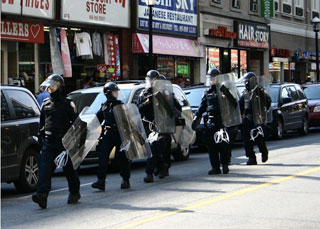Staying safe in ‘dangerous’ places
 One of the most common objections to traveling the world is the supposed danger involved. After all, the world is full of nasty stuff — war, crime, murder, kidnappings, beheadings and so on — why needlessly expose yourself to all that? While it’s easy for those who’ve actually traveled to world to laugh at such questions, most of us still draw a few lines.
One of the most common objections to traveling the world is the supposed danger involved. After all, the world is full of nasty stuff — war, crime, murder, kidnappings, beheadings and so on — why needlessly expose yourself to all that? While it’s easy for those who’ve actually traveled to world to laugh at such questions, most of us still draw a few lines.
Despite a handful of slightly insane people, like say war correspondent Robert Young Pelton, who wrote and updates The World’s Most Dangerous Places, most of us do not want to deliberately place ourselves in harm’s way. Yet if you listen to the U.S. State Department you’d never leave your couch.
So how do you really know if a place is dangerous or not? Well, the answer is you really don’t until you go. I’ve been to numerous places considered dangerous and found them far safer than the shady neighborhoods in my own hometown. That said I do have one rule: don’t go to active combat zones.
Popular travel blogger Gary Arndt is currently in Acapulco Mexico, a country that many people consider quite dangerous (home to drug gangs, kidnappings and even the occasional beheading). Before he left, Arndt wrote a long post on traveling to dangerous places and has some great tips for those who want to get out of their comfort zone without taking Pelton-style risks. Here are a few of Arndt’s suggestions, as well as a couple tips for what to do if you find yourself in over your head:
- Are tourists being targeted? In many places, like what is happening in Tunisia currently, it has nothing to do with Americans, westerners or even foreigners. If the problems are internal, you probably don’t have too much to worry about. If, like in Yemen, tourists are specifically targeted because they are tourists, you might want to think twice. Likewise if they are targeting groups you might belong to or foreigners in general.
- Do problems exist in the city or region you’ll be visiting? As I explained above, many countries are quite large and lumping everything together makes no sense. Make sure you get specifics on where you will be, don’t just get news at the country level, unless the country is really small.
- Could you get caught in the middle of things? Even if you aren’t a target, that doesn’t mean you can’t
- Be inconspicuous. Don’t stay in the most expensive, well know hotel in a city. Don’t look like a tourist if you can avoid it.
- Have an escape plan. During the Bangkok protests, I had a plan for getting out of the city if thing blew up. (Taxi to Pattaya.) When I was photographing the protesters, I had an escape plan for getting off the street I was on. (Run up a parking ramp and into an office building with embassies). Just giving a few minutes of thought to what you would do if things went bad could save you if it does.
Be sure to read the whole post for some background and more tips, and if you’ve got your personal “dangerous places” criteria or suggestion on how to stay safe, be sure to post them in the comments.
Riot Squad on Yonge Street photo by Christos Tsirbas/Flickr/CC

January 25th, 2011 at 2:52 pm
[…] This post was mentioned on Twitter by vagablogging, Andrew Stoffman. Andrew Stoffman said: Staying safe in ‘dangerous’ places: One of the most common objections to traveling the world is the supposed dan… https://bit.ly/eU9uar […]
January 25th, 2011 at 11:00 pm
Best way to “Staying Safe” – Plain old Common Sense. One can actually “smell” danger. You always have to base on what you can personally get out of fast..the older you are the less reaction time, or even the ability to outrun someone else.
September 19th, 2013 at 2:14 pm
[…] Rolf Potts has been a travel reporter for publications such as National Geographic Traveler, the New York Times Magazine, Conde Nast Traveler, and Outside, in addition to National Public Radio and the Travel Channel. His blog shares travel tips and destination profiles. Some interesting recent posts include Travel Talismans, Jjimjilbangs in Korea, and Staying Safe in “Dangerous” Places. […]